Nanoparticle vaccine activates immune system against HPV tumors
Researchers at the German Cancer Research Center (DKFZ) and the SILVACX project group at Heidelberg University have developed an innovative vaccination concept that can mobilize the immune system specifically against cancer cells. In a mouse model, the vaccine based on silica nanoparticles showed promising results against HPV-related tumors by partially pushing them back completely.
Human papillomaviruses (HPV) are the main cause of cervical cancer and also play an important role in tumors in the head and neck area as well as other types of cancer. While preventive HPV vaccinations can prevent infections, there has been a lack of therapeutic vaccines that fight existing tumors or precancerous lesions. The new method relies on silica nanoparticles that are loaded with virus protein fragments that can activate the immune system.

The nanoparticles made of silicon dioxide, also known as silica, are stable and have already been tested in medicine. They are coated in a biocompatible manner and equipped with specific virus peptides. After injection, antigen-presenting immune cells take up the particles and present the viral epitopes, activating cytotoxic T cells. These recognize and destroy cancer cells in a targeted manner. The combination with an adjuvant was particularly effective.
In mice with humanized immune systems presenting human epitopes, the vaccination led to a strong T-cell response. In some of the animals, HPV-positive tumors disappeared completely, and survival time was extended. The silica nanoparticles protect the vaccine components from degradation, improve their bioavailability and are easy to produce. In addition, they could be used in regions without a cold chain, which facilitates their worldwide application.
The findings, published in the journal Oncoimmunology, suggest great potential. The method could be used not only against HPV-associated cancers, but also against other tumors or infectious diseases. The researchers plan to further develop the technology in order to transfer it into clinical application and improve the treatment of cancer patients.
Original Paper:
Editor: X-Press Journalistenbû¥ro GbR
Gender Notice. The personal designations used in this text always refer equally to female, male and diverse persons. Double/triple naming and gendered designations are used for better readability. ected.




